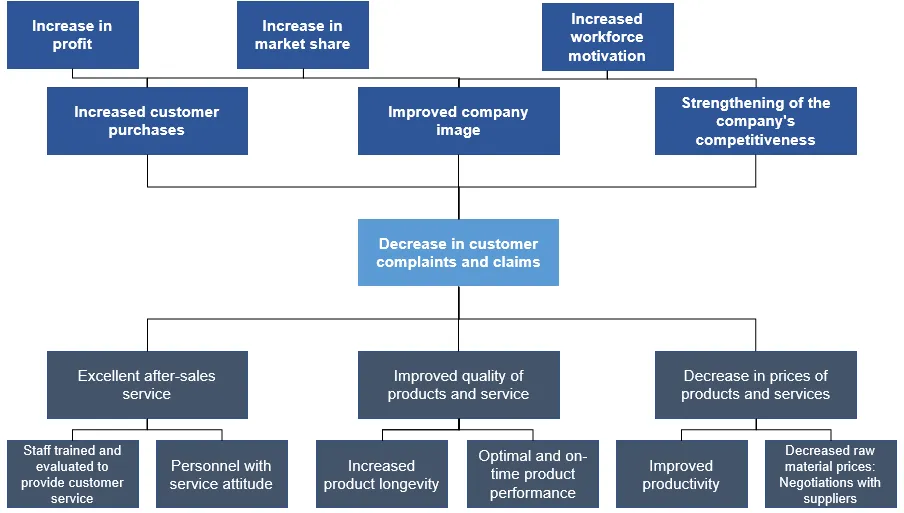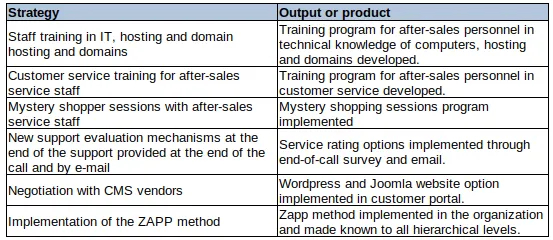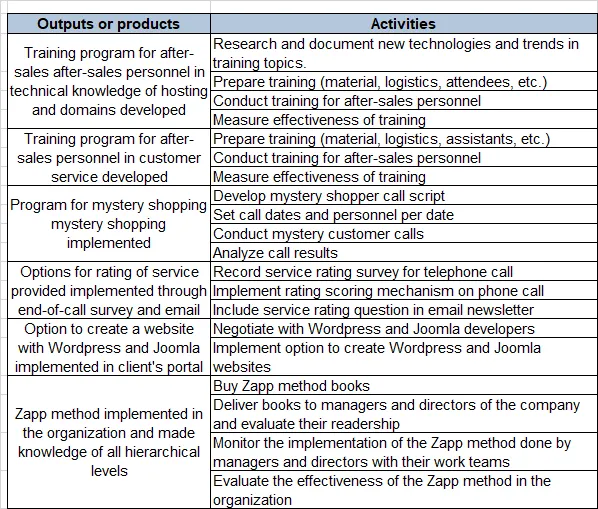In the next step in the logical framework methodology (LFM) we will make a hierarchical representation of the alternative chosen in the analysis of alternatives, which will make the transition to the logical framework matrix easier.
How do we do this?
With the project analytical framework (PAF).
Another post on the Logframe methodology:
- Example of a logical framework
- Stakeholder analysis
- Problem tree
- Objective tree
- Analysis of alternatives
- Analytical project structure
- Project Narrative
- Project indicators
- Means of verification
- Project assumptions
This is today’s topic in Ingenio Empresa.
What is the analytical project structure
What has been constructed in the problem tree, objective tree and analysis of alternatives is embodied in the analytical project structure.
The analytical project structure is usually defined as the schematization of the project. An outline of the relationship of the optimal alternative with the objectives and actions. This relationship is presented in the form of a tree through hierarchical levels organized vertically.
- Bottom of the tree: Activities
- Second level of the tree: Outputs
- Third level: Purpose
- Top level: Project goals
How to make the analytical project structure
Step 1: The project goal
With the goal or goals of the project you describe how through your intervention (the whole bottom part of the analytical structure) you are going to generate a solution to the central problem.
Another way to define the purpose is: why is the project important? The answer should match what we would think of as the long-term impact of the project’s contribution; and we say contribution because the goal is not necessarily generated once the project is completed. In fact, it is more common for the goal to be generated as a long-term impact.
For example: Achieving a decrease in complaints and claims made by customers will not achieve:
Increase market share, profitability and employee motivation by itself.
It will contribute to this, of course. But not in isolation, as it depends on other, much more complex factors.
The immediate increase in market share, profitability and worker motivation. This will be a long-term impact.
How to do it: Take the goals or the goal at the top (the leaves) of the objectives tree. This will be the top of the analytical project structure.
Step 2: The purpose of the project
The purpose is the result or effect of having the project completed. According to the logical framework methodology, the project title originates from the purpose, which is why there should be one per project in the logical framework matrix.
The purpose is achieved through the production and implementation of the outputs. It will not be enough to have the outputs or products made. To achieve the purpose, you must use them.
For example, the “training program for after-sales personnel in customer service” will not contribute to reduce customer complaints if it is only trained once. This training should be a permanent part of the company, being periodic for current and new employees of the company.
How it is done: This is the same as the central objective of the objectives tree. It is connected to the goal or goals of the project.
Step 3: Project Outputs
The outputs are the goods or services (tangible products) resulting from the project to fulfill the purpose.
Consequently, we must write them as the result of an action. In fact, and in anticipation of the logical framework matrix, the outputs are defined as results.
How it is done: In the outputs you place the result of having executed the strategies (actions) of the analysis of alternatives.
Step 4: Project activities
In the activities you define what you will do to fulfill the strategies and deliver the outputs.
Personally I like to call them macro-activities, because in this step we define only the most relevant ones per output.
Of course there will be times to define them in detail, but this will be done in other instances of the project planning, for example when the disaggregated work breakdown structure (WBS) or the responsibility assignment matrix is elaborated.
How is this done? Define the activities required for each output in chronological order.
Step 5: Generate the Analytical project structure
Having all the steps done, the only thing left to do is to draw the analytical project structure.
How to do it: I show you with an example of an Analytical project structure.
Example of project analytical structure
We will continue with the Colusa Inc example that we have been developing in the problem tree, objectives and alternatives analysis.
The objectives tree:

And the optimal strategies of the analysis of alternatives:
- Staff training in IT, hosting and domain knowledge.
- Elaborate mystery shopping sessions with after-sales service personnel.
- Implementation of support evaluation mechanisms at the end of the call and by e-mail sent to the customer.
- Provide training to technical support staff.
- Negotiation with CMS providers to provide the customer with quick and easy installation.
- Implementation of the Zapp method
Step 1. The goals of the project are in the objective tree at the top.
- Profit increase
- Market share growth
- Increased workforce motivation.
Step 2. The purpose of the project is the central objective in the objective tree.
- Decrease in complaints and claims made by customers.
Step 3: The project outputs are generated from the strategies defined from the alternatives analysis.

With this, we have finished the analytical structure of the project.
Step 4: What activities are needed to carry out the strategies? Now, we define the activities from the outputs:

Step 5: The above steps are consolidated in the analytical project structure as follows:
With this done, we are ready for the next step in the logical framework methodology.


very good and simple language and We need more elaborate concept explanation but it is sufficient enough to be a project officer. I ask you to continue educating us and send me some of more complex projects analysis.
Thank
Otherwise I really Appreciate so much for the initiative.
Yours Sincerely David Tombe
Thank you so much for the beautiful explanation, however I have a clarity quest. When we use the Result framework approach, the goal is equivalent to the impact as per your explanation, and the output is the same in both cases. But which one is equivalent to the outcome? Is it the purpose? If so, are we going to have only one outcome? Or we don’t have an outcome at all in Logical framework approach? And we goanna have three impacts? In the example you have provided there are three goals. I got confused.
Thanks for the instant reply, in fact this what I wold like to get clarifications
like
Outcomes and impact, and Goal or are used interchangeably and purpose which come first
Thanks